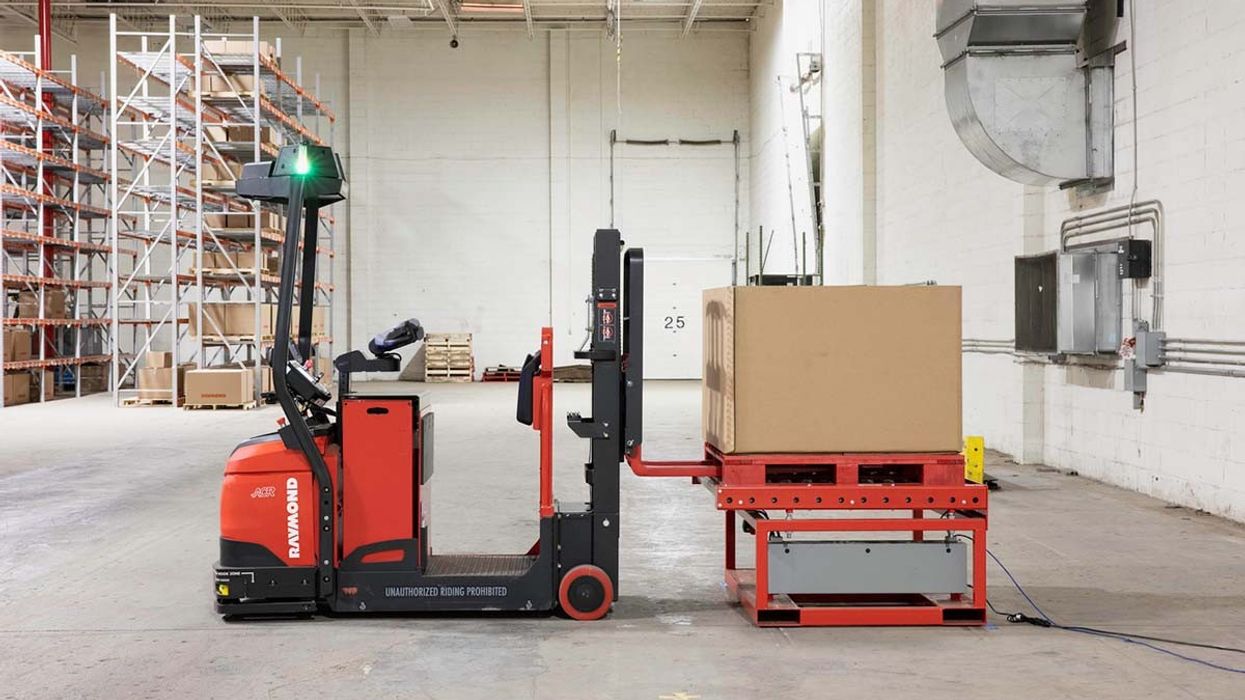Robotic technology has been sweeping through warehouses nationwide as companies seek to automate repetitive tasks in a bid to speed operations and free up human labor for other activities. Many of those implementations have been focused on picking tasks, a trend driven largely by the need to fill accelerating e-commerce orders. But as the robotic-picking market matures and e-commerce growth levels off, the robotic revolution is shifting behind the picking lines, with many companies investing in pallet-handling robots as a way to keep efficiency gains coming.
“Earlier in this decade and the previous decade, we [saw] a lot of [material handling] transformation around e-commerce and the handling of goods to order,” explains Josh Kivenko, chief marketing officer and senior vice president at Vecna Robotics, which provides autonomous mobile robots (AMRs) for pallet handling and logistics operations. “Now we’re talking about pallets—moving material in bulk behind that line.”
Kivenko explains that whether items are being packaged and shipped directly to a customer’s home address or moved as finished goods to a shipping bay for store delivery, those items are first moved in bulk in some way, often by human hands and with human-operated equipment. He describes warehouses as chaotic environments in which humans move pallets and cartons in multiple ways—up and down, side to side, from receiving to storage, from storage to shipping, or via cross-docking. Automation can help bring order to that chaos.
“What we’re trying to do is relieve some of the pressure [on the] humans [doing] this work,” Kivenko says of companies that develop pallet-handling robotic technologies. “At the end of the day, we’re trying to automate some of those flows, relieve labor pressure, save costs, and keep the goods flowing.”
But automated pallet handling isn’t right for every situation, so it’s important to understand the warehouse conditions required and the protocols and best practices needed to make it a win. Here are some guidelines for applying pallet-handling robots and gaining the most from your investment.
FIRST, UNDERSTAND THE TECHNOLOGY
Pallet-handling robots fall into four general categories, explains Rich O’Connor, vice president of storage and automation for Raymond West Group, a business unit of lift truck manufacturer The Raymond Corp. They include:
- Palletizing/depalletizing robots, which are used to load or unload items onto and off of pallets, usually with the use of a robotic arm for picking and placing. Today, these systems are being increasingly integrated with automated storage and retrieval systems (AS/RS) to further streamline pallet handling in the warehouse, O’Connor explains.
- Autonomous guided vehicles (AGVs) and autonomous mobile robots (AMRs), which are used to transport pallets within the warehouse. Often outfitted with lift decks or conveyors, or designed to tug or tow items, these robots move pallets from point A to B within a facility. AGVs, which often follow a marked guide-path or wire in the floor, have been around for many years, but the advent of high-performance guidance and vision systems is allowing them more flexibility today, O’Connor says. AMRs are self-guided vehicles that use software and sensors to navigate their way through the warehouse.
- Forklift AGVs and AMRs, which can move products both horizontally, from place to place, and vertically, into and out of storage racks. They come in various styles—including stackers, counterbalanced trucks, reach trucks, and even very narrow aisle (VNA) vehicles for use in densely packed warehouses. These vehicles are more complex than those used only for horizontal transport, O’Connor explains. They must be “highly integrated” into the facility’s warehouse management system (WMS) or warehouse execution system (WES) so that they know precisely where to retrieve and deliver pallets within the facility.
- Robotic pallet shuttles, which move pallets into, out of, and within dense storage racking. The Raymond Corp. describes such a system as “a standalone, automated deep-lane pallet storage system that utilizes self-powered shuttle carriages to move pallets toward the back or front in a racking channel. Shuttles are motor driven and travel along rails within a storage lane.”
O’Connor and others say that no matter which of these technologies you’re investing in, it’s important to remember that they are all part of a larger system designed to optimize operations throughout the warehouse.
“The expanding role of all these different styles working together is what’s amazing today,” O’Connor says.
SECOND, ENSURE THE TECHNOLOGY IS A FIT
Kivenko, of Vecna, also emphasizes the importance of pallet-handling robots working in concert, particularly AMRs and AGVs.
“The magic isn’t just that the robots are autonomous and driving by themselves. The magic is multiple robots—when you have a [whole integrated] system [in place],” he says. “[It’s] how the fleet operates autonomously and optimizes itself for continuous improvement. That’s where the exponential gains are. [It’s] not just about automating what a worker does; it’s about automating a system.”
But you can’t install these systems in just any warehouse and expect magic. Kivenko and others point to certain conditions that enable the best robotic pallet-handling outcomes, especially when it comes to transportation-based and forklift-type AMRs and AGVs.
“The robots that I sell are large-load machines with very expensive technology,” Kivenko explains. “They move material, generally, in larger facilities. And in order for them to produce a return [on investment]—because that’s the name of the game here—they have to be higher-velocity facilities.”
He says pallet-handling robots work best in large facilities running multiple shifts, usually more than five days a week. Wider aisles allow the equipment to move more freely through the facility and at higher speeds, to optimize efficiency and productivity. Strong Wi-Fi networks and clean, dry environments also help keep equipment running at top performance.
O’Connor agrees that pallet-handling robots are best suited to facilities with multishift operations, where they can ease labor constraints and boost productivity. And he says many customers are willing to extend the typical two- to three-year ROI period to five years in order to achieve those gains. But there is even more to it than that. O’Connor’s colleague John Rosenberger says customers must first step back and analyze their processes to ensure that, even if they have the right facility for pallet-handling AMRs or AGVs, they are moving material in the most efficient way to begin with.
“Many times, we find that the processes in place [are inefficient],” says Rosenberger, who is director of iWarehouse Gateway and global telematics for The Raymond Corp. He emphasizes the importance of analyzing existing data—from an equipment telematics system or similar—to determine the best path toward automation.
“Do you have congestion zones now?” he asks. “They’ll still exist if you automate [those processes exactly].”
THIRD, MAKE SIMPLICITY A PRIORITY
Another basic rule of thumb when implementing pallet-handling robotics: Keep it simple.
Andy Lockhart, director of strategic engagement for global warehouse and logistics process automation company Vanderlande, says that when designing a pallet-handling robotics system, “you want to minimize the processes you [automate]. When you can create [an automated system] that focuses on one task—for example, AMRs delivering pallets from a high-bay [storage rack] directly to the palletizing cell—you can do that efficiently and effectively. When you ask the AMR to do this and this and this … you are adding risk of failure.”
Lockhart’s colleague Jake Heldenberg advises customers to first test their target processes via pilot programs within the warehouse or DC. Heldenberg is Vanderlande’s head of solution design, warehousing, North America.
“If AGVs or AMRs for pallet handling are interesting [to a customer], the best thing to do is pilot one or two in an existing DC,” he says, explaining that the process can help companies troubleshoot, understand integration timelines, and gauge ROI. But pilot programs can add expense to a project, making it unaffordable for some.
“If that’s the case, then the best advice is work with a vendor who has experience integrating [the technology],” Heldenberg says. “Use their experience to benefit your business. You won’t have the same hiccups and challenges you would with a less-experienced vendor.”
















